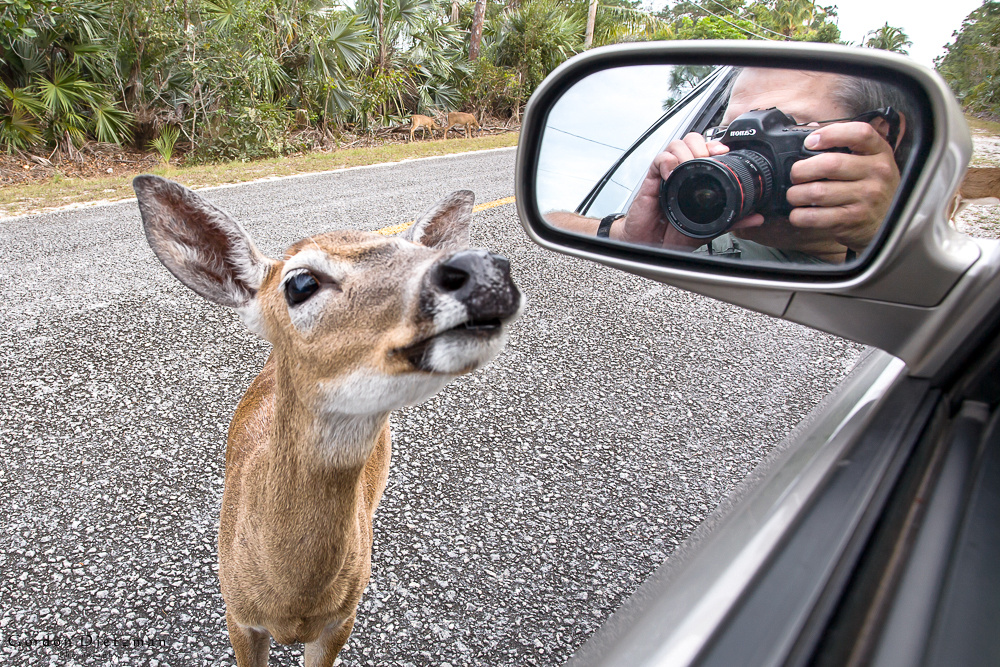
On our very first trip to Florida--at least my first trip to Florida--Deb and I were hoping to see key deer as we drove the highway out to Key West. Despite their low numbers and endangered status we found them--easily.
These tiny deer (adult does only weigh about 40-60 lbs. and bucks only slightly more) are an endangered subspecies of white-tailed deer. The Minnesota whitetails that frequent my backyard, for instance, easily weigh four to five times as much! The Key deer look frail and almost fawn-like even as adults. They are about the same size as a large golden retriever and most do not exceed 26" tall at the shoulder. Fawns only weigh 2-4 lbs. at birth. They are really tiny.
They are only found on the islands of the Florida Keys and have been isolated from other populations of whitetails since the close of the last ice age when rising sea levels inundated what was most of the then Florida coastline leaving only the coast as we know it and the curving string of Keys that jut out into the Gulf of Mexico. While they are good swimmers, and often swim between islands to find forage and fresh water, they cannot reach mainland Florida because of the width of the Moser Channel between Bahai Honda Key and Boot Key. Several thousand years of isolation from the mainland has produced a sufficient genetic divergence from mainland deer populations to warrant the subspecies designation. Their scientific name is Odocoileus virginianus clavium, which is a subspecies of O. virginianus. the whitetail which are familiar to most of us.
The deer are highly habituated to humans and many panhandle for treats on the road and roam people's yards. Their proximity to the roads and other infrastructure often lead to them being struck by cars and attacked by dogs. About 70% of annual mortality is due to being struck by cars. That amounts to about 125-150 deaths per year out of a population of 700-800 animals.
This particular deer approached our Honda Civic looking for handouts but only received some photo publicity for her efforts. It was important to get as much depth-of-focus as possible so I set aperture at f10 to get the entire deer, road, car, and the environment in focus. The photo that I was imagining was one of this tiny deer looking up at the camera and using the 17-40mm wide-angle lens to enlarge the face relative to the rest of the body and to emphasize the questing nature of her behavior. I had not thought about the possibility, however, of using the rearview mirror as an element in the photo until I saw myself in the mirror while looking through the viewfinder, but when I did I knew the mirror needed to be included in the photo as it helps illustrate the uneasy relationship between Key deer, people, handouts, and proximity to roads and the cars that threaten these endangered animals.
Equipment:
- Canon 5D
- Canon 17-40mm lens
- ISO 200, 1/80 sec., f10 with no compensation
Low temperatures are both a curse and a boon for insect macrophotography. Insects are more active in warm temperatures making them easier to find while cold temperatures have them scrambling--albeit more slowly--to find cover. That, of course, makes them harder to find but easier to photograph once they are found as they are less likely to startle, flee, or hide. While chilled insects slow down, they are still capable of scurrying or flying off so moving slowly around them is still advisable. But having a semi-torpid subject provides the photographer with more time to contemplate and compose the photograph. An added benefit is that there are fewer mosquitoes to bother the photographer's concentration...grin.
I found this robber fly perched on a leaf this morning trying to warm up.
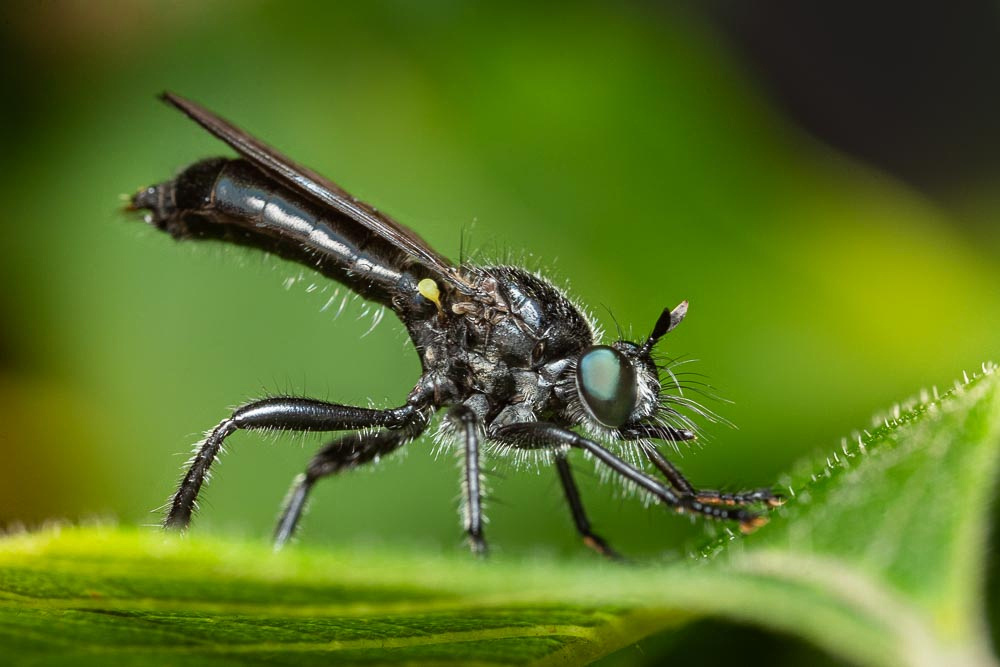 Robber FlyRobber flies often lurk on leaves, as this one is doing, to either warm up or to ambush their prey.
Robber flies have a worldwide distribution with just under a thousand species in the United States. They come in all sorts of shapes and sizes, including some that resemble bumblebees. They also seem to prefer drier areas. In Minnesota, I find most robber flies in sand prairies, but they will also show up in our suburban yard. Robber flies are predators and hunt primarily flying insects although they may also take spiders on occasion. They often sit in ambush on leaves like this one is doing and watch for passing insects. They are fast, agile, and powerful fliers that track their prey down in mid-air, intercept and grasp prey in their powerful legs, and carry it to a convenient perch for consumption. I don't know if they can calculate angles and anticipate how to plot an intercept course with their prey as some research suggests dragonflies do or if they simply overtake their prey from behind. Regardless of their pursuit methodology they have both excellent eyesight and great awareness of their surroundings making them quite difficult to approach, although some species are easier to approach than others. Those robber flies that have caught and are feeding on prey also tend to be a bit easier to approach.
Robber FlyRobber flies often lurk on leaves, as this one is doing, to either warm up or to ambush their prey.
Robber flies have a worldwide distribution with just under a thousand species in the United States. They come in all sorts of shapes and sizes, including some that resemble bumblebees. They also seem to prefer drier areas. In Minnesota, I find most robber flies in sand prairies, but they will also show up in our suburban yard. Robber flies are predators and hunt primarily flying insects although they may also take spiders on occasion. They often sit in ambush on leaves like this one is doing and watch for passing insects. They are fast, agile, and powerful fliers that track their prey down in mid-air, intercept and grasp prey in their powerful legs, and carry it to a convenient perch for consumption. I don't know if they can calculate angles and anticipate how to plot an intercept course with their prey as some research suggests dragonflies do or if they simply overtake their prey from behind. Regardless of their pursuit methodology they have both excellent eyesight and great awareness of their surroundings making them quite difficult to approach, although some species are easier to approach than others. Those robber flies that have caught and are feeding on prey also tend to be a bit easier to approach.
This robber fly allowed a close approach in this morning's cold air. In fact, it was so docile I was able to pluck a nearby leaf that was partially blocking my view without disturbing it. Even then the composition wasn't right so I carefully removed the leaf on which the fly was sitting and moved it to a more desirable background, something neither action would be tolerated by robber flies in warmer weather.
Equipment used for this photo:
- Sony A7III
- Sony flash with diffuser
- Canon MP-E65 macro lens set to 1:1
- Handheld
 Before retiring, I worked as a park ranger for the National Park Service. Each permanent NPS employee takes two weeks of training, called Fundamentals, at the Grand Canyon. It is an impressive place to take training, but the schedule doesn't leave much time to actually explore the Canyon or even look at it as rangers and other staff spend most of their time in an Albright Training Center classroom and when we were in the field we were working. Certainly there wasn’t much time for photography and for this photographer it was sometimes difficult to concentrate knowing that just a few hundred yards away was one of the world's great scenic wonders.
Before retiring, I worked as a park ranger for the National Park Service. Each permanent NPS employee takes two weeks of training, called Fundamentals, at the Grand Canyon. It is an impressive place to take training, but the schedule doesn't leave much time to actually explore the Canyon or even look at it as rangers and other staff spend most of their time in an Albright Training Center classroom and when we were in the field we were working. Certainly there wasn’t much time for photography and for this photographer it was sometimes difficult to concentrate knowing that just a few hundred yards away was one of the world's great scenic wonders.
Each day after training, I'd rush out of those confining classrooms, grab a camera and run to the rim to find places to shoot. Sometimes I'd hop in the car and drive up or down the canyon to look for photo opportunities. Usually, I didn't get to the rim until the sun was setting, but the light every evening was glorious. Shadows would stretch from the peaks and slowly fill the valleys. So gorgeous, so many opportunities.
On this night, I was tired—really tired--and despite the grandeur that spread out in all directions I was struggling to find inspiration. I stood there casting about for a new idea or a unique perspective without finding anything. The sun was setting and clouds were moving in. The light became very soft and I was despairing about getting anything that would illustrate the enormity of the landscape, which even when you are there is difficult to comprehend.
Then I noticed these hikers sitting on a pinnacle. Often adding something of known size helps a viewer better understand scale. In addition, I noticed a single beam of light coming through the clouds just above the rim and streaming into the canyon. It was edging its way up the pinnacle and I began to imagine the hikers lit by that beam of golden light set against the pastel colors of a canyon in shadow. I could also see the many layers of crenullated ridges in the background. There wasn't going to be much time to set up and I wasn't in the right place for the composition I was imagining. It would be a race to get into position and there was always a chance that the sunbeam wouldn't hit the hikers anyway, but I had to try.
I snapped on a 70-200 zoom, shouldered my pack, and jogged west rapidly along the rim while occasionally looking back to see where the light was and where I needed to be. It was further than I expected, but I got to a good spot just as the sunlight spotlighted the hikers. I spun around, dropped to my knees and shot 14 photos before the light faded away and the canyon slipped into the darkness. Most of the photos were blurred due to the slow shutter speed, but this one was sharp and, as luck would have it, it was the best one of the bunch.
I like mixing dialectics, those characteristics that seem opposed to each other and this photo has several of them. I like the warm light on the hikers contrasting with the cool light of the canyon walls, the brightness of the hikers and the dimness of the canyon walls, the smallness of the hikers with the massive character of the Canyon.
One viewer on my Facebook page observed that it is very difficult to capture the enormity of the Canyon, but he added that this photo does it as good as any he had ever seen. High praise.
]]>
I get a bit stymied about my usual daily hike when it is this cold, but I also want to take some photos. Just a few minutes ago a coyote loped through my backyard. I missed him, but now a cardinal is sitting on the bush just outside the patio door and that is an excellent opportunity to get in a few shots and practice some processing and maybe even writing a quick blog article about shooting through window glass. I'll do that....

Window glass does not posses lens-quality optical characteristics. It would be nice if it did, but that would be a bit expensive. In fact, in my past I worked for a telephone engineering company at about the time that we began designing for fiber optics. We think of glass as being clear but go to your local big box hardware store and take a look at several sheets of glass stacked together and you'll realize looking through that blue-green mess that it doesn't take very many sheets of glass before you can only see vague shapes moving on the other side. Now imagine shooting a light signal through thousands of feet of fiber optics versus a couple of inches. The nearly perfect optical clarity and lack of imperfections in fiber optic filaments is an engineering marvel. Yes, the messenger light is laser but even a laser won't sufficiently penetrate several sheets of window glass in good enough shape to carry a reliable signal. That window glass quality creates a problem for photographers who are used to lens-glass-quality sharpness in their photos. We need to find ways to minimize the loss of sharpness without opening the window which would, of course, cause us to freeze in the weather that would give pause to a caribou.
All the usual stuff still applies: interesting subject, good lighting, good composition, steady holding of the camera, shutter speed, etc. Once all of that is taken care of we need to think about that darn multi-paned, double or triple insulated window glass. Of course, the glass should be clean as possible, but eliminating reflections, shooting perpendicular to the glass, and not being right up against the glass are three things I keep in mind when shooting through glass.
Cleaning the glass is important, but maybe not as important as some might think. I've not cleaned the patio door through which I took this photo since last fall. The above photo is pretty sharp. Not as sharp as if I had slid the door open, but then the cardinal probably wouldn't have stuck around for the photo if I had done that. But, yeah, keep the window as clean as possible, or whenever you think of it.
Eliminate reflections. Reflections on the glass are distractingly awful and degrade contrast and sharpness. If I flip off the lights in my office to shoot through the patio door I don't have reflections but my office doesn't have any windows that would throw light on me from behind or to the sides that would cause me and other items in the room that would cause reflections. It also helps if the inside is darker than the outside so I always turn off the lights in the office when shooting through glass. Some people put rubber hoods on their camera lens and press it up to the glass. That works, too, but read the next paragraph. Oh, and don't use flash. that creates an enormous reflection--this is all natural light technique unless you rig up a wireless flash outside and control it from your camera inside where it is warm and cozy.
Because I can control the reflections in my particular situation, I like to stand back several feet from the window when shooting through it. Shooting close to a window, I believe, can work, but if there is an imperfection in the glass between you and the subject it your photo will tend to blur and lose contrast and definition. Standing back further, for me at least, seems to reduce that issue as glass blemishes are likely to cover a smaller area in relation to the photo's frame. It also gets me away from the window where my subject may spot me.
Photos will be their sharpest if you are shooting perpendicular to the glass. Light rays must pass through more glass as the angle increases. Remember what I wrote above about several thicknesses of window glass? Window glass, even the best window glass, gets more opaque as it gets thicker and if you are shooting at an angle through glass there will be more glass in the way. When the amount of glass increases through which you are shooting, the more likely there will be blemishes as well with which to contend. And, of course, the light will have to pass through more dirt, if you've forgotten to clean the window in the last year, or more.
Lastly, be sure to open up your aperture to reduce depth-of-field. Doing so will reduce the impact of blemishes in the glass. And be sure to move around a bit to shoot through different spots on the glass as glass imperfections are not always obvious through the viewfinder.
What do you think? Do you have other ideas for managing sharpness when shooting through window glass?
]]>
The white-tailed deer of Villa Park and surrounding areas have finished their annual breeding season, known as the rut. During that stressful season, the bucks have been intimidating foes and impressing potential mates with their antlers and bigger antlers are better. Large antlers, in the communications department of Deer, Inc., denote good genetics, abundant food, and good health--all desirable qualities in fending off rivals and attracting mates.
Antlers are different than horns. Horns are permanent growths that keep growing and wearing (or chipping off). Animals that have horns include sheep, cows, bison, and antelopes. Antlers, such as those that adorn the crowns of of the white-tailed deer, are grown and shed each year, usually about now, and they begin to regrow in spring. The largest antlered bucks are usually 5-7 years old and the shedding of the antlers allows them to increasingly grow larger antlers as they mature.
The process of growing antlers is driven by a cycle of hormones. The deer right now are shedding their antlers in Villa Park as testosterone levels drop to their lowest levels of the year. The pedicel, where the antler connects to the skull, weakens and at some point the antlers drop off leaving a raw area that scabs over. At this point some folks, like the two men I ran into a week ago in Villa, make it a hobby to search the woods to find these dropped "sheds." Since I don't see many bucks in Villa at this time of year--it is primarily a fall and early winter spot for bucks--this probably isn't the best place to hunt shed antlers as the deer are usually someplace else when the antlers drop.
Testosterone levels stay low until spring when they slowly begin to rise spurring antler growth. The new antlers are covered with a soft "velvet" skin rich in blood vessels that nourishes the rapidly-growing underlying tissues.
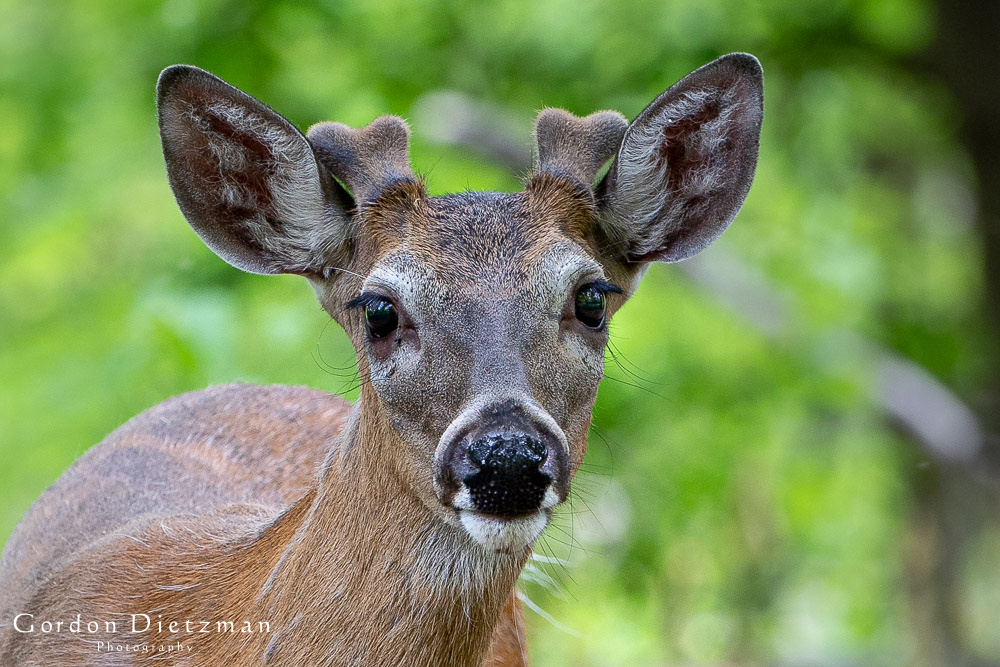
I took the above photo in May while the photo below was taken a month later. These two bucks, I believe, are two different animals, although we rarely get bucks in our backyard in summer. Despite that you can get an idea of how fast antlers grow. It's also interesting that calcium is an important part of antler growth and so the bucks need a lot of calcium-rich foods for maximum antler growth, which is mediated, of course, by genetics and other factors. Does don't grow antlers but they need calcium for the bones of developing embryos and for milk once their fawns are born. Interestingly, bucks and does need about the same amount of calcium but just for different purposes.
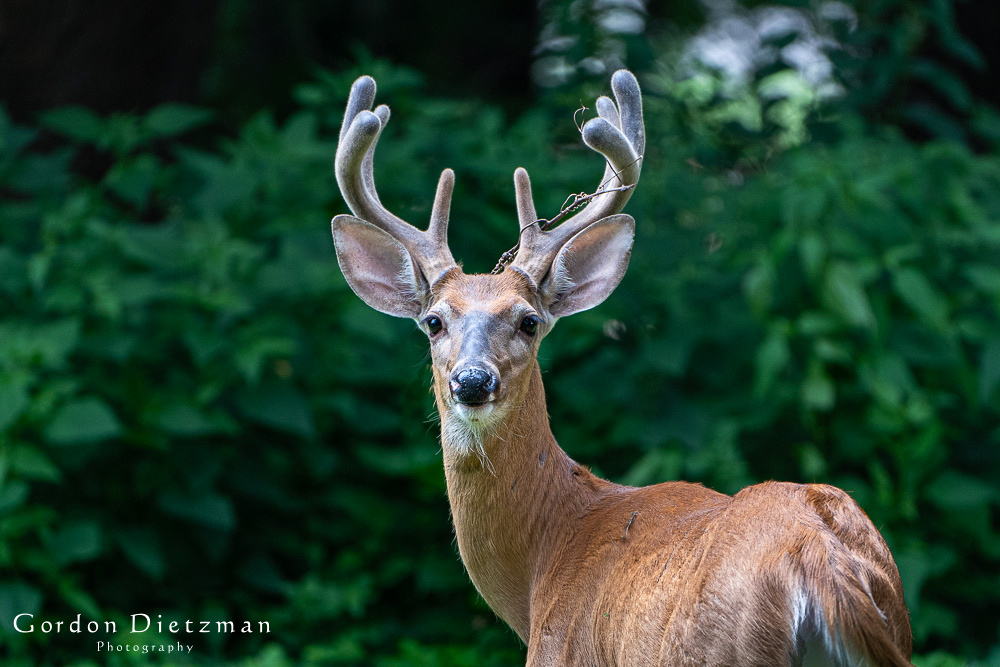 Later in August testosterone levels continue to peak and the relatively soft bone calcifies and harden as in the photo below. The bucks then thrash bushes stripping off the velvet. The blood along with sap from the bushes often stain the antlers a dark brown, although the tines may remain light-colored due to wear. By late October testosterone levels are at their highest and bucks that have been pals since the previous winter began to see those buddies as rivals and by November violent dominance fights may break out among those former friends.
Later in August testosterone levels continue to peak and the relatively soft bone calcifies and harden as in the photo below. The bucks then thrash bushes stripping off the velvet. The blood along with sap from the bushes often stain the antlers a dark brown, although the tines may remain light-colored due to wear. By late October testosterone levels are at their highest and bucks that have been pals since the previous winter began to see those buddies as rivals and by November violent dominance fights may break out among those former friends.
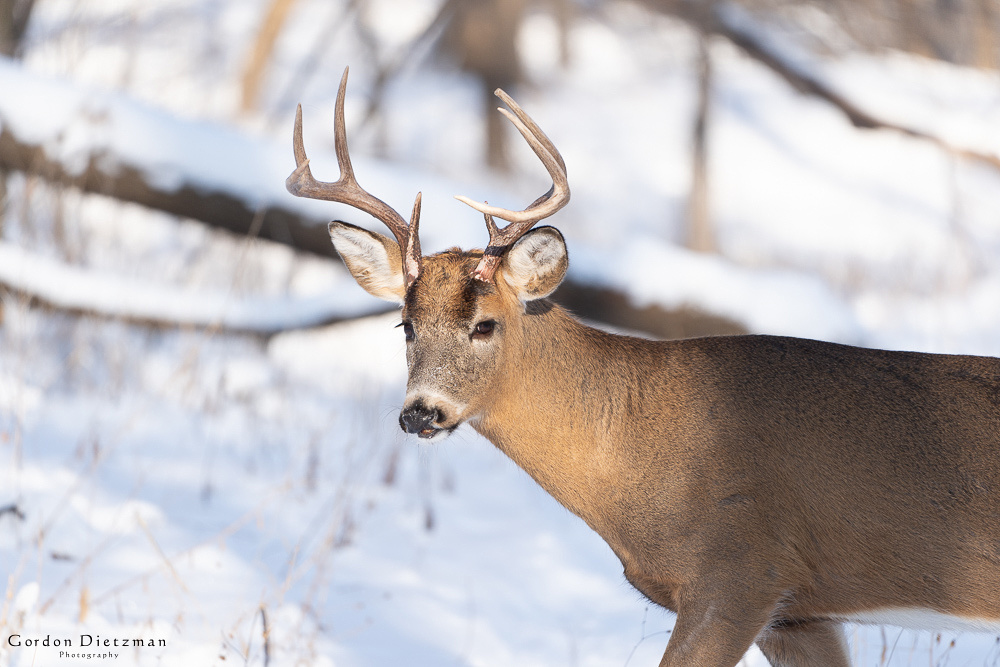
The photo above shows the fully-antlered buck with the velvet stripped off. I photographed this particular buck numerous times this fall and this photo and the next two are of the same animal. The above photograph was taken on January 3. The photograph below was taken a month later on February 4. He's lost one antler (both antlers rarely drop at the same time).
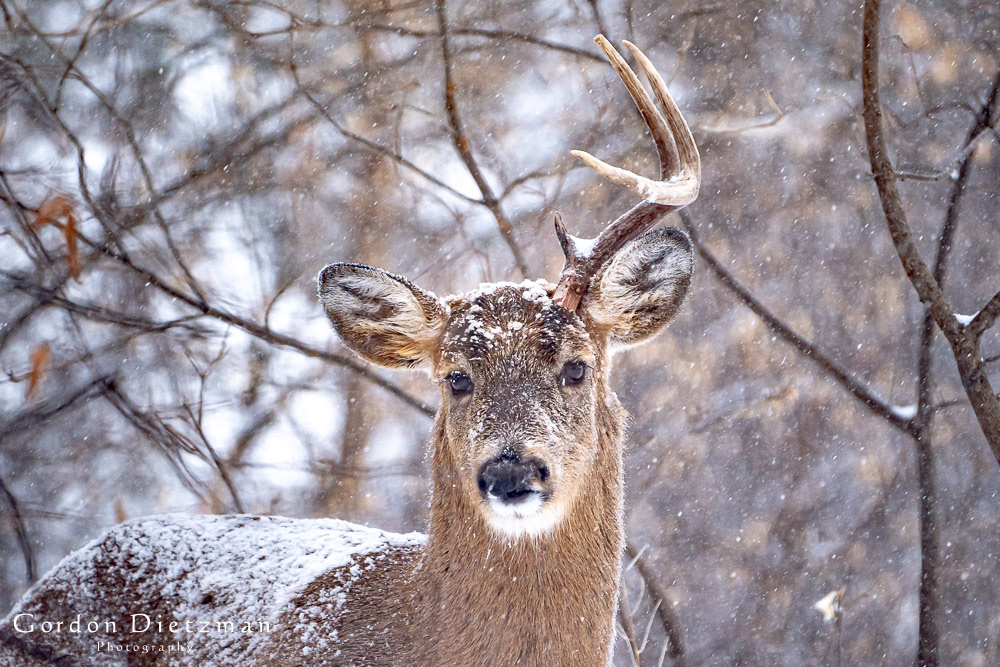
 In the photograph above, taken on February 6, the buck has now lost both antlers and the pedicel on this side is scabbing over.
In the photograph above, taken on February 6, the buck has now lost both antlers and the pedicel on this side is scabbing over.
There are, however, some conditions that may interfere with the cycle. Injuries and stress may cause the bucks to drop their antlers early. A few years ago I captured a video of a very large buck in Villa with a birdfeeder swinging by a chain from his antlers. At some point he had severely injured his shoulder and was able to only hobble around. It was a painful thing to watch. Fortunately, he shed his antlers early in January ridding himself of the birdfeeder. He survived his broken shoulder--perhaps he had run into something fleeing this human-made object swinging from his antlers. Although he lost the use of a front leg, I saw him repeatedly for at least four years after his birdfeeder encounter. Interestingly--and I've seen examples of this before with deer that have broken legs or--his antlers grew back the following spring in an odd formation. Instead of a massive, symmetrical, tub-sized rack, his antlers were deformed and shot nearly straight up out of his head. This is not an uncommon result of a serious injury.
I enjoy watching and photographing deer. They are amazing athletes. They are fast, great leapers, and the behaviors governed by the natural pecking order are fascinating. Antlers are pretty amazing things and serve as an important means of communication between deer.
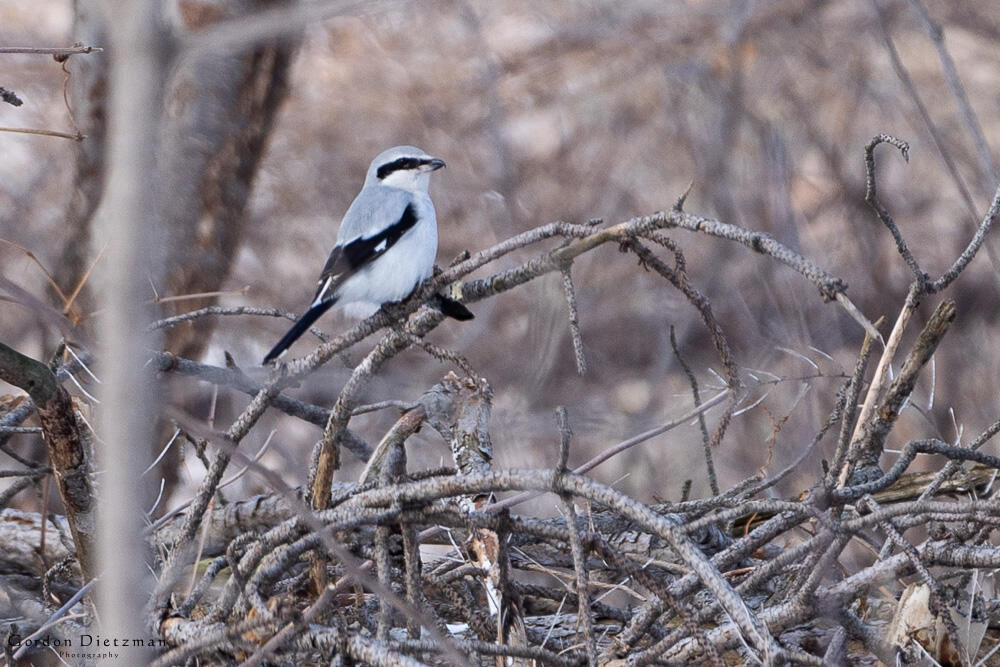 They are one of the more interesting songbirds because of a lifestyle that is fairly unique among songbirds. They have a fun, bubbly, warble of a song, but this bird plays up that role of innocent songster in a rather surprising way. Most songbirds eat a lot of insects and seeds and the robin-sized shrike will as well but that hooked bill is a bit ominous. It hints at a different lifestyle and shrikes live up to that hint by taking not only insects, but mice, voles, and even other birds, including those that are larger than themselves!
They are one of the more interesting songbirds because of a lifestyle that is fairly unique among songbirds. They have a fun, bubbly, warble of a song, but this bird plays up that role of innocent songster in a rather surprising way. Most songbirds eat a lot of insects and seeds and the robin-sized shrike will as well but that hooked bill is a bit ominous. It hints at a different lifestyle and shrikes live up to that hint by taking not only insects, but mice, voles, and even other birds, including those that are larger than themselves!
Shrikes have strong feet but not as strong as a hawk's talons which the latter uses to kill its prey. Lacking that tool the shrike uses its bill to kill. That places its vulnerable eyes close to dangerous prey so they need to make a quick kill to reduce the possibility of injury to themselves. A shrike's bill have two small projections on either side of the upper bill that fit into corresponding notches in the lower bill. This "tomial tooth" provides a vertebrae-crunching bill that quickly incapacitates prey. Northern shrikes often catch more prey than they can eat at one time and the excess is cached often by impaling the victim on barbwire or thorns for consumption later on. This behavior gives them one of their alternative names of "butcher bird."
I found the shrike during yesterday's hike as it was consuming a freshly caught downy woodpecker. It flew off before I got any good photos of it, but this morning I searched the area again and found it polishing off the remains of yesterday's meal and got this photo. Northern shrikes are handsome, aggressive birds that masquerade as just another songbird, but with an appetite of a hawk, the ability to subdue large prey quickly, and to store it for future use. It's a fascinating, elegant-looking, uncommon bird which we rarely get to see.
Being a naturalist tips the balance, I believe, in finding and photographing birds and other animals. For instance, I knew that shrikes set up winter territories so I was likely to find the elusive bird again if I hung around the area where I first spotted it. Secondly, a downy woodpecker is about half the size of a shrike, which makes it a very significant meal. I suspected that the shrike had not finished the meal but had probably cached the remains in or around the brush pile where I first spotted it. While I didn't see the cached remains, I was back at the brush pile the next day where I found the shrike finishing his meal.
Understanding behavior of a target species allows the nature photographer to increase the likelihood of finding subjects.
]]>As I was wandering around on that hike I ran across this white-tailed deer as he fed in the forest. I know this buck having photographed him several times in the last couple of months and, I think, he thinks of me as just about the most inept and boring predator in the forest. So much so that he pretty much ignores me. I like that. Making wildlife photographs is so much easier when deer are doing things that they do when they are not watching us.
Still, I moved slowly moving into a position where the background was going to be as good as it could be and hoped he would walk into it, which he did. For those of you who know me, I believe that backgrounds are so important that I spend as much time finding a nice background as I do a subject and I pass up a lot of shots simply because a suitable background isn't available. I really don't need more mediocre photos of white-tailed deer.

Then he laid down in a patch of winter-killed white snakeroot. There was only a tiny opening in the weeds and there was only one place where I could stand to minimize the obstructions between the camera and the subject. I moved to that spot and took a couple more photos, but it was, by itself, not a particularly fetching shot, but photons are cheap and I had time to spend waiting for something better.
As I watched another hiker appeared moving through the background. The buck studied her for a few seconds, dismissed her as a threat, and resumed chewing his cud. "Nice" I muttered in my best David Attenborough voice, "This is the very thing, that thing, that intangible, the very story of wildlife living amongst us." The hiker never knew that she was a part of that story and she passed just 40 feet from us unaware of our presence.
 As I stood there I wondered how often we miss wildlife. It's a question that I've pondered before. Wild animals usually prefer fading into the background employing both camouflage and behaviors to avoid detection. Just standing still works really good for whitetails. Just ask any hyper-alert photographer that has just experienced an unseen deer suddenly erupting from the brush just 40 feet away. The senses of wildlife are, usually, much better than ours because their lives depend upon their ability to detect and evade predators and they use those senses to detect us and then choose some strategy to avoid us.
As I stood there I wondered how often we miss wildlife. It's a question that I've pondered before. Wild animals usually prefer fading into the background employing both camouflage and behaviors to avoid detection. Just standing still works really good for whitetails. Just ask any hyper-alert photographer that has just experienced an unseen deer suddenly erupting from the brush just 40 feet away. The senses of wildlife are, usually, much better than ours because their lives depend upon their ability to detect and evade predators and they use those senses to detect us and then choose some strategy to avoid us.
There are few ways to know what we miss.
A number of years ago, I was hiking the Gunsight Trail through the postcard-perfect mountains of Glacier National Park to the picturesque Sperry Glacier Chalet. The hiking was easy for the first several miles along a rushing Sprague Creek, but then things got harder with the trail clinging to steep terrain and switchbacks that led up to a cirque, a hanging valley glacially sculptured out of the valley's headwall. As I puffed my way into this tiny cirque I knew I'd have a hundred yards or more of flat hiking and most importantly I'd get a breather and really get to enjoy the spectacular scenery. And awe-inspiring sights extended in all directions. The air was clean and crisp with that edge that imbues mountain air. Gorgeous mountains rose all around and the view down the valley to Lake McDonald was inspiring.
I strode past a reddish-orange sign warning me that grizzlies were frequenting the area. Seeing these signs always gives me pause and perks up the alert levels a couple of notches and it was with some relief when the chalet finally hove into view. As I approached the chalet I noticed a gray-and-green clad park ranger sitting on the edge of the cliff peering intently through his spotting scope into the valley through which I had just hiked.
I plopped my weary behind down beside him and pulled out a bag of walk-around gorp sprinkled liberally with that backcountry currency sometimes referred to as M&Ms.
"Watch you watching?" (I already knew.)
He looked at me from under his NPS ball cap and then at my M&Ms. I extended the bag to him and he took a handful and stuffed a couple in his mouth.
"Have you seen any bears?" he countered.
My ears perked up. "Recently, you mean?" I counter-countered.
"Yeah, like 30 minutes ago."
"No...." I replied. I paused, "Should I have?"
He grinned with the knowledge of someone who knew something I didn't. I extended the gorp bag and he selectively rifled through the granola for another helping of my limited supply of M&Ms. He popped one appreciatively into his mouth. "Yes, you walked past a grizzly sow with a small cub. You didn't see her, but she saw you. She was bedded down just off the trail, but she stood up and looked at you as you walked past and then laid back down."
On another close encounter, I was portaging a canoe in Ontario's Quetico Provincial Park. At the end of the trail I wearily slid the canoe into the lake and leaned up against a fallen tree to take a breather. It was a hot and sweaty day and it felt good to lean into a tree and just to savor the day, the trail, the lake, the jackpine-scented air, but before I could settle in I spied a suspicious indentation at the water's edge and I wandered over to take a closer look. It was a perfect wolf track neatly pressed in lakeside mud. Now, wolves are not uncommon in the area and neither are the signs of their passing. At night it isn't unusual to hear a pack howling and tracks sometimes litter the softer parts of trails in this hard country. It is, however, rare to see one. This track, though, was somewhat unique among tracks that I'd seen before because a slender tendril of water was flowing into the indentation made by the interdigital pad (sometimes thought of as a heel pad). The wolf had to have just been there. I took a quick look around, but the wolf was gone, probably. Possibly it was watching me from behind a screen of nearby Labrador tea, maybe. I had just missed seeing a wild wolf and the only remaining clue was this track slowly filling with lake water ticking off the time between the wolf's departure and my arrival.
A few years before that my Brother-in-law and I were hiking up Cascade Canyon in Grand Teton National Park when we stopped to catch our breath in a small meadow that we had just entered. The magnificent scenery would have taken our breath away if we hadn't lost it already slogging our way up a steep incline. Magnificent country, wonderful scenery. Then I heard something, very close, take a very deep breath. I spun around to spy a bull moose standing about 20 feet off the trail we had just come up. We flat-landers had missed it completely in our oxygen-deprived state as we passed by the hulking behemoth. But the amazing thing was that after we watched the statue-still moose for several minutes we suddenly spotted a second bull just 20 feet from the first one. How could you miss one of the biggest animals on the North American continent at the range of only a few feet, stare at it for several minutes, and then duplicate that dubious feat by missing a second one just a few feet from the first?
My point in recounting these stories is that we miss things even when we think we are being observant. As photographers we miss photographing things that we never see either because they remain hidden or because we aren't looking and, only rare instances, will we know what we missed. I'm sure that I've walked past bedded deer, hunkered snowshoe hares, coiled rattlesnakes, sleepy moose, alert elk, crouching bears, wolves, lynx, and that these encounters are known only to them.
I have no comprehensive solutions to seeing more animals. There are the little things such as looking for tiny movements: a flicker of an ear or that of a tail, but a deer is very good at not being seen if it doesn't want to be seen. This spring I often found Nashville warblers by watching for twitching snakeroot plants as those tiny birds fed unseen deep in the vegetation. A horizontal line amongst the verticals of a forest may be just a fallen log, but it may be the backline of a deer, moose, or elk. I usually spot snowshoe hares by spotting their black eyes amongst the snow. And I can now spot an insect crawling across a flower twenty feet away out of the corner of my eye when I'm shooting macro shots. Practice in seeing those things helps and I probably see more than most people do simply because I spend so much time looking.
For me the realization that I miss things keeps me more alert in the field, but I'm equally sure I miss a lot even in a heightened state. Still, that is the adventure of photographing wildlife and makes me appreciate those things that I do see and maybe that is good enough.
And that little grizzly family in Glacier National Park? The next day I left the high country and headed back down the valley. The ranger was again stationed on his rock peering through his spotting scope. He grinned at me when I asked if the grizzly was still there. (I knew, of course, it was.) He didn't answer me directly but suggested singing or whistling while walking through the cirque would be a good idea, unnecessarily adding that he'd watch my progress from his safe perch a half mile away. Great. I didn't see her that time either and I wonder if she saw me. I'll never know...
]]>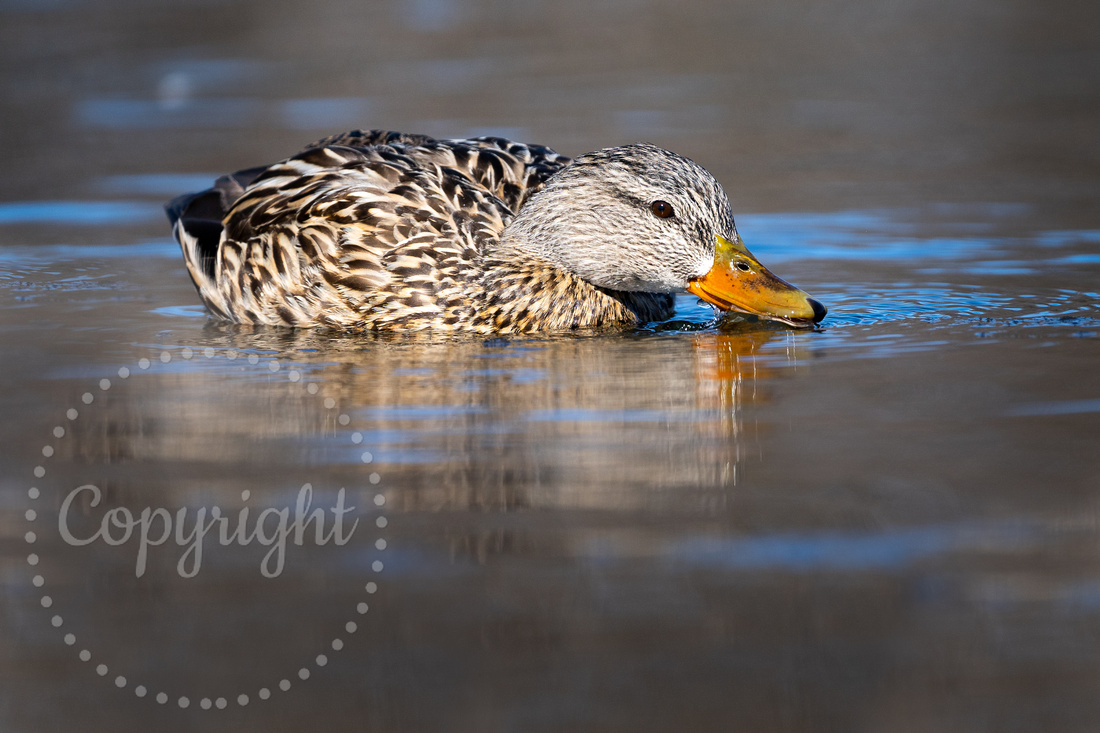 Sometimes there isn't anything to photograph than mallards, but that doesn't mean they should be ignored. They are gorgeous animals with beautiful patterns (females) and colors (males). Their problem is that they are so common that we tend to overlook their beauty. But there is the challenge; how do we take an imaginative, eye-catching photo of something that is common?
Sometimes there isn't anything to photograph than mallards, but that doesn't mean they should be ignored. They are gorgeous animals with beautiful patterns (females) and colors (males). Their problem is that they are so common that we tend to overlook their beauty. But there is the challenge; how do we take an imaginative, eye-catching photo of something that is common?
In this particular instance, I headed to the local duck pond to test out a new camera and lens (Sony Alpha A7III and Sony 100-400 G lens) and mallards fit the bill (no pun intended) for experimentation because I could take lots of photographs in a relatively short period of time. It's also important to get an intuitive feel for one's equipment by actually using it--a lot--and numerous subjects help do that.
One of the things I really like about the Sony is the pull-out tilting back monitor, something that my older Canons lacked. Using this feature I could get all the way down to nearly water level by tilting the LCD up and using it as a waist level finder (or, in this case, by sitting on the shoreline and using the LCD as an ankle-level finder). It's hard to keep the camera level while doing this but the Sony also has a level feature that can be superimposed over the potential picture on the LCD in real time. It will take some practice to use the level finder while composing the photo, but it gets the image close to level and I can make any final adjustments in Lightroom.
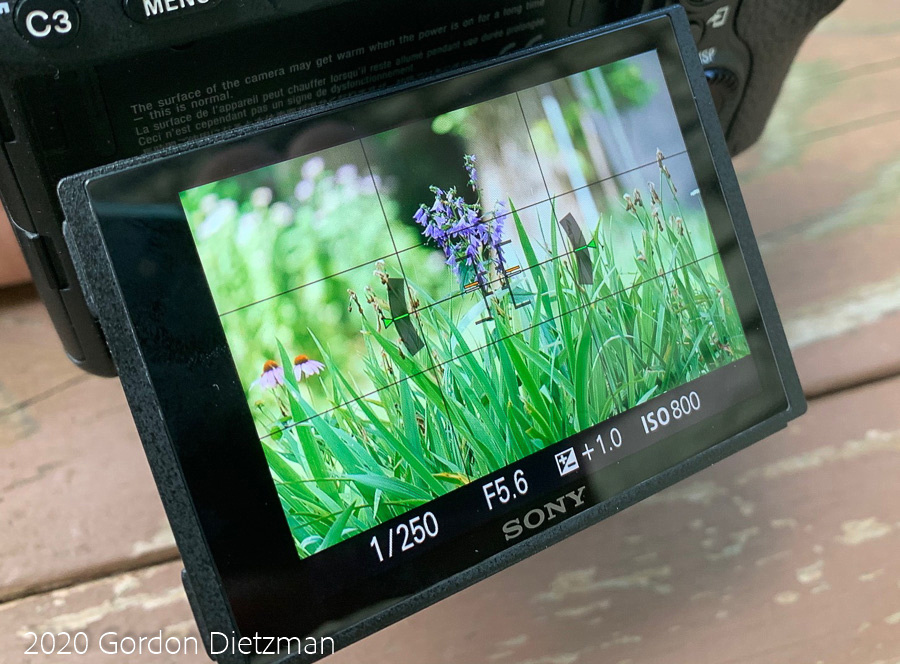
Getting down low changes the viewpoint of both photographer and those that view the photograph. Think of what this does, in this instance, to most backgrounds. If I was shooting at a normal eye-level height the background would be just inches behind the duck and in focus. By getting down low, the background is several feet away, out of focus, and much more pleasing as it eliminates distractions. Just as importantly, it puts the viewer into the world of the duck as we see the world from its perspective rather than from that of a photographer. To further enhance this effect I deliberately placed the duck high in the frame to put lots of out-of-focus water in the foreground.
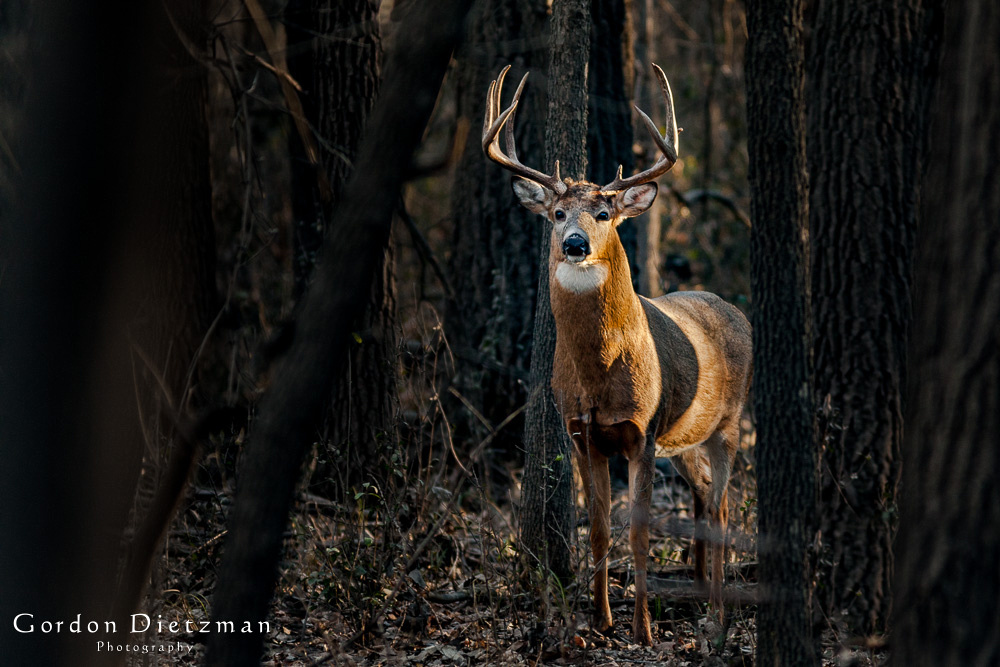
Shortly after moving to the Twin Cities in Minnesota I set about exploring the area for photo opportunities. It was hard, photographically speaking, to have moved to another state and having lost all my favorite hotspots that I knew so well. Now I had to research, and experience, new places. I'd heard about photographing big bucks in the Mississippi River bottomlands in the metro so that fall I began roaming the banks of the river trying to find them.
Early one morning I was back at it meandering along the Mississippi River on a trail that wandered through the woods. The sun was just peeking above the trees across the river with a few rays were straying through the quiet forest when I suddenly realized I wasn't alone. The big buck was close and cautiously regarding me, lit by a golden sunbeam in a gray forest. My first reaction was one of shock. How did I get that close to a buck without seeing him?
For several seconds, maybe a minute, we stood there looking at each other before he went on his way slipping among the trees and sunbeams until out of sight. Then he was gone and I was left standing there in the forest fixing the moment in memory.
Since then I've photographed many large bucks in many other places, but this particular encounter will always stand out as one of the defining moments in my photo career.
How I Got This Photo
The contrast between the dark forest and the "spotlighted" deer makes determining exposure difficult. I had to expose for the deer, the subject, and not the forest which covers most of the photo. The camera doesn't really know what the subject is and what its exposure should be. As a result, it will tend to try to brighten the photo which will blow out the detail of the deer. As a result, I dialed in a -1.5 f-stop to make the forest dark again and to "darken" down the deer to the appropriate exposure.
To do this one needs to know how the camera will see the scene and not how you see the scene and that requires lots of practice.
]]>
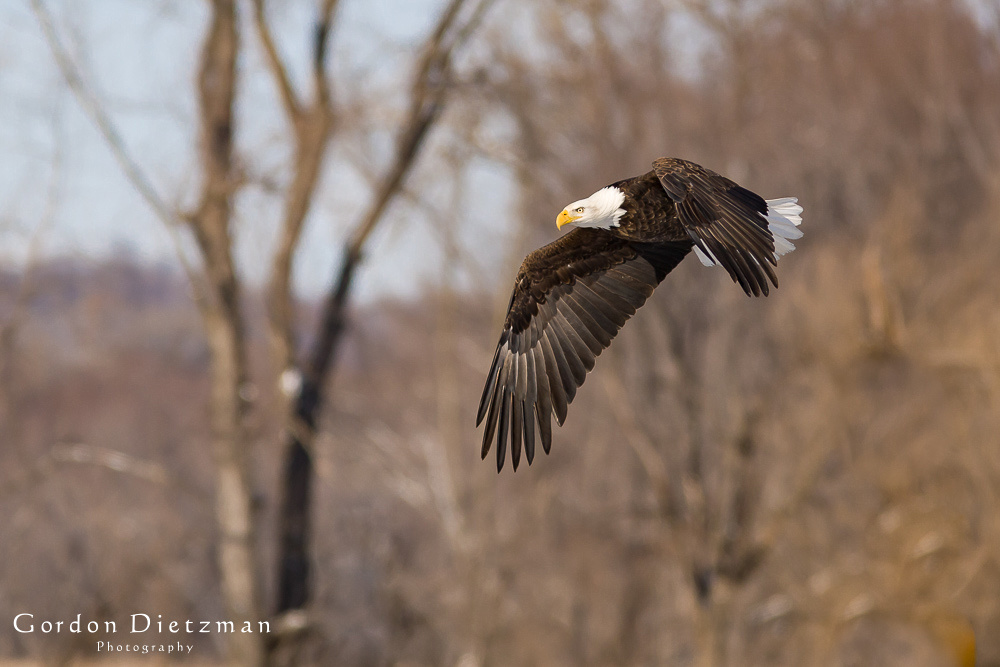
"Wild Neighbors of the Mississippi River" Exhibit
September 26 through late August, 2020 (The exhibit is now closed.)
Macalester College's Smail Gallery (Olin-Rice Science Center)
Saint Paul, Minnesota
A digital version is available at this website. Use the captions below to better understand the concepts of the exhibit and then see the exhibit.
Wild Neighbors of the Mississippi River
The Mississippi River as a Conservation Success Story
About the Exhibit
The exhibit is fashioned in panels that contain between one and six photographs, each with its own concept. One can follow the exhibit concepts using this document and the photographs that are numbered by panel.
The Minnesota stretch of the Mississippi River is bounded by northern mixed forests, eastern deciduous forests, floodplain forests, and western tallgrass prairie. This rich environment hosts an enormous diversity of wildlife, but that has not always been the case. The river, heavily polluted in the early 1900s, lost its fish, birds were uncommon, and most mammals were missing from the landscape.
The Mississippi River of today is much different than the impoverished river of a few decades ago. While the river faces emerging challenges, its water and air are cleaner, and we have developed a greater appreciation and tolerance for the wild neighbors which have returned to its waters and shores. The photographs of this exhibit capture complex lives in split second increments but will, hopefully, call us to enjoy the life of this great river in person while prompting us to work to ensure its further recovery.
Gordon Dietzman describes himself as a "curious photographer/naturalist" interested in wildlife, science, and art. He holds a degree in Interdisciplinary Studies (emphasis in environmental interpretation) from the University of Wisconsin. He is recently retired from the National Park Service but also has worked in agriculture, environmental education, the conservation of endangered species, and engineering. His photographic and employment with the National Park Service focuses on the upper Mississippi River basin, but he has photographed wildlife and wild landscapes across North America and Southeast Asia.
Exhibition Captions
Panel 1 – This 40x60” print of a resting White-tailed Deer is intended to be an eye-catcher. And it is. When you walk past the photograph the eyes of this nearly life-sized deer follow you.
Panel 2 – These six photographs illustrate in part the great diversity of life along the Mississippi River. The river acts as a refuge for both common and uncommon species as well as species that were once common, then rare or missing, and then their return. For instance, white-tailed deer populations were once sparse along the river, but their population has recovered, in some people’s eyes, to pest status.
- Painted Turtle
- Snowy Owl
- White-tailed Deer
- Ruby-throated Hummingbird
- Baltimore Oriole
- Ring-billed Gull
Panel 3 – Great Horned Owls find refuge along the river and have spread out into neighborhoods. These powerful aerial predators were not welcomed at one time, although we now have come to tolerate and even enjoy their hooting on wintry nights as they set up breeding territories.
Panel 4 – These four photographs of migratory birds illustrate the beauty and diversity of migratory birds which enliven our lives. Their epic journeys are dependent on interstate and inter-continental cooperation to protect summer, wintering, and important migratory habitat that links those two places. In this way, birds are ambassadors to countries we will never visit and people we will never meet yet which inextricably connect us across the globe.
- Great Egret
- Green Heron
- Solitary Sandpiper
- Eastern Bluebird
Panel 5 – Trumpeter Swans were once common in Minnesota, but were largely shot out by the late 1800s, a time frame in which many species were either locally eliminated or seriously diminished. I used to travel all the way to Idaho’s Red Rock Lakes National Wildlife Refuge to see these rare and magnificent birds. But today one of the best places to see these largest of waterfowl is in the upper Mississippi River basin. They nest across a large swath of Minnesota and Wisconsin, but we have two major wintering areas in the Twin Cities area. One is at Monticello’s Swan Park and the other is at Hudson, Wisconsin. Both locations are within easy driving distance of the Twin Cities.
Panel 6 – The Resurgence of Diversity: In 1926 a survey along 75 miles of Mississippi River through the Twin Cities found only three living fish. Sewage, waste products from lumber and flour mills and animal carcasses from stockyards were dumped into the river depriving the river’s inhabitants of oxygen as bacteria broke those wastes down using oxygen in the process. Today, there are about 120 native species of fish in the river, along with several non-native species. While we do not often see the underwater resurgence of the river’s diversity, we can see the signs above the river in in increasing populations of fish-eating birds, such as pelicans and eagles. The floodplain forests also are home to the beautiful wood duck, another once rare bird brought back from the edge of oblivion by the conservation of habitat and construction of thousands of nesting boxes that mimic the hollow trees in which they once nested.
- Commercial fisher releasing a non-targeted muskellunge.
- American White Pelican
- Bald Eagle
- Wood Duck
Panel 7 – Cope’s and gray tree frogs live within our area. These two species are nearly impossible to tell apart in the field, except by the somewhat subtle differences in their trilling calls, so they are often referred to as a species complex. We often hear their calls on warm, humid summer evenings, although we probably attribute the sound to birds.
Panel 8 – Emerging Threats: Despite the elimination of many of the traditional pollution challenges, the Mississippi River in the upper basin faces new threats. Loons, swans, eagles and other fish-eating birds may consume and be poisoned by lead lost in the river and surrounding areas by both anglers and hunters. Loss of insect populations endanger insectivorous birds, such as swallows and other species. Invasive species, such as bighead carp, threaten the ecological integrity of the river.
A previous generation made the decision to recover the river and they have passed it down to us. Now it is up to us to determine the future of the river for the next generations.
- Common Loon
- Commercial fisher with invasive Bighead Carp
- Tree Swallow
- Yellow Warbler
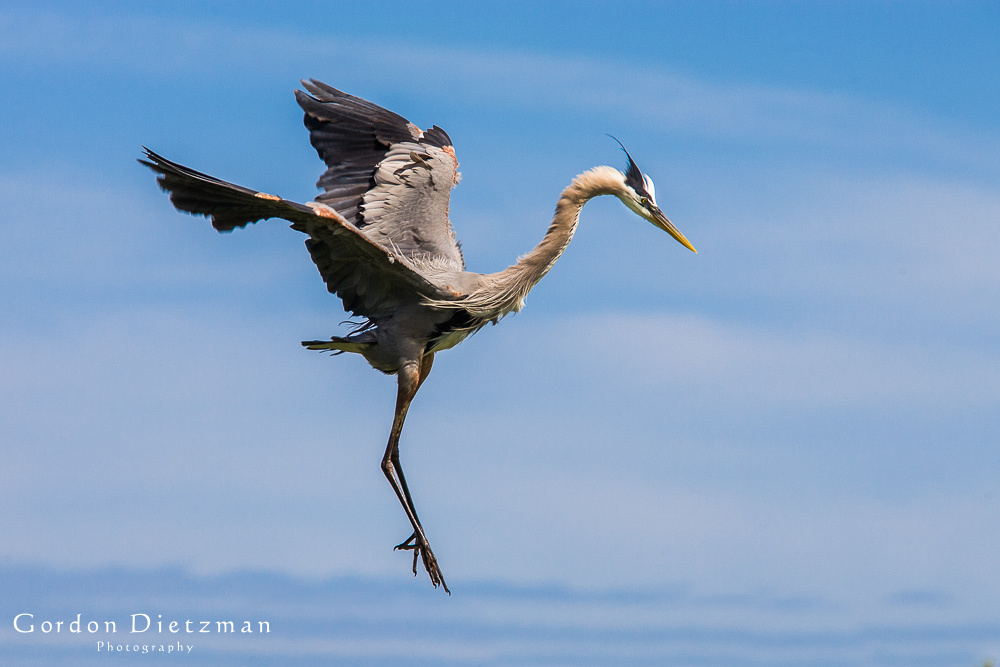
Wind and large birds make for great photography and today was no different as we stood on the edge of the pond that contains the famed Venice Rookery in Venice, Florida. The wind was blowing hard and it was gusty. Conditions like this make it difficult for these large birds to land, especially when the tree branches in which they intend to land are also swaying violently.
Wind forces the birds into dramatic aerial maneuvers as they tried to line up with branches next to their nests and yet far enough away from other nests to avoid the sharp, stabbing bills of their protesting neighbors.
Some of the birds were building nests, others tending chicks or eggs so the birds had no choice but to leave the rookery to find twigs for nest-building or food for the chicks. As a result, there were many photo opportunities as the birds passed overhead or crossed in front of us.
Equipment Setup
- Canon 5D
- Canon 300 f4L, 1.4x converter
- ISO , f-stop , shutter speed
Scenario
The rookery at Venice is "reachable" using a 400mm lens on a full frame camera, but longer would be better. I shot this photo in the morning from near the picnic shelter and shooting west putting nice light on the birds. The wind on this day was blowing from the south, something to consider as the birds tend to land into the wind and that correlation increases once the wind is blowing more than just a few miles per hour.
The pool is also home to at least one large alligator that probably feeds on chicks that fall from the nest, but also chases fish that also inhabit the pond. Not only are there blue herons here, but also cormorants, great egrets, and other species of smaller herons.
Nature Notes
The great blue herons are often thought of stalking the shallow waters of ponds and rivers, but they are sometimes found hunting upland fields for amphibians, reptiles, and rodents.
Location:
4002 S. Tamiami Trail, Venice, FL 34293. Travel south on the access road to the parking lot across from the picnic shelter.
]]>
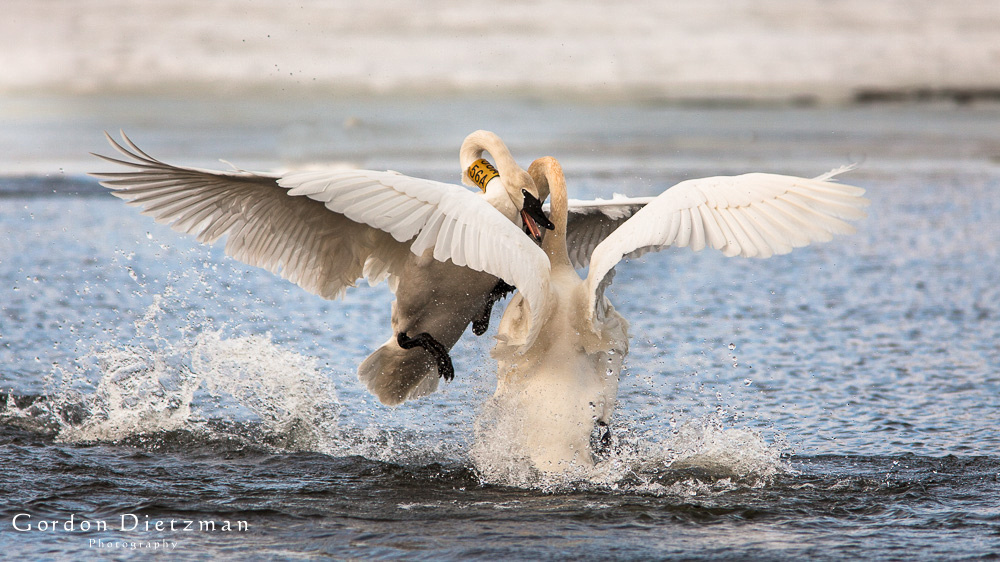 Trumpeter Swans were a once rare species. In fact, in the 1970s I'd travel all the way to Idaho's Red Rock Lakes National Wildlife Refuge to find and photograph them. The photographic results were less than stellar. There were only a few there and they were often far too far away to get good photographs. That, however, wasn't a deterrence even though it was a 2,600 mile trip from my then home in Wisconsin.
Trumpeter Swans were a once rare species. In fact, in the 1970s I'd travel all the way to Idaho's Red Rock Lakes National Wildlife Refuge to find and photograph them. The photographic results were less than stellar. There were only a few there and they were often far too far away to get good photographs. That, however, wasn't a deterrence even though it was a 2,600 mile trip from my then home in Wisconsin.
Today, Trumpeter Swans are fairly common in the upper Midwest after reintroduction programs. These are really big birds, weighing up to 38 pounds, and they can pack a powerful blow from the wings driven by muscles capable of lifting their big bodies into the skies and keeping them there for hours. They are wild animals that can be aggressive and need to be treated with respect, so I'm always cautious around them.
I have a couple of favorite places to photograph these birds. My favorite place to get flying shots of these big birds is just up the road at Monticello, Minnesota. (I now live in the Twin Cities area of Minnesota.) They winter on the Mississippi River right in town and they are a big draw as any magnificent animal would be. About 2,000 winter here at a feeding station. They fly in and out regularly and offer a constant parade of aerial opportunities.
The second location is in Hudson, Wisconsin on the St. Croix River. It is possible to be sitting on the edge of the ice and have Trumpeter Swans swim--or waddle--past within a few feet. This is the area the photo above was taken. While I've taken lots of good flying photos of Trumpeters here, I prefer Monticello for those type of shots. Here it is more about behavior. Most of the winter the Trumpeters are pretty placid, but as spring approaches and hormones begin to peak the birds start to become more aggressive in defending their personal space and their mates. Fights like this one are common, but one has to be watching behavior as pairs slowly approach each other bobbing their heads and be ready as these fights don't usually last very long.
In summer, a good place to photograph Trumpeters and their young would be the Crex Meadows State Wildlife Area in northwestern Wisconsin. If you spend enough time here, you will find them near the roads. But, as one might expect, they are more cautious around people and a bit more wary when they have young.
Photographic Tips:
- I like to photograph these birds in late morning at both wintering areas. At Swan Park in Monticello, the photographer is pointing east so a sun streaming over the shoulder is good. Food, however, is put out for them in the morning and this is when they are flying the most. At Hudson, the photographer is pointing west, so the sun is in the east in the morning. Wind direction can also play a part as these big birds like to land against the wind. At both Monticello and Hudson, I line a wind from the north.
- I use a 300mm + 1.4x converter on a full frame and cropped sensor cameras.
- Flying shots usually require a blue sky, just to help set off these brilliant white birds. But don't forget shooting white birds in the fog. The results can be simply gorgeous.
SPECIAL NOTE: The number of swans at both of these locations has dwindled significantly as they are no longer being fed.
]]>
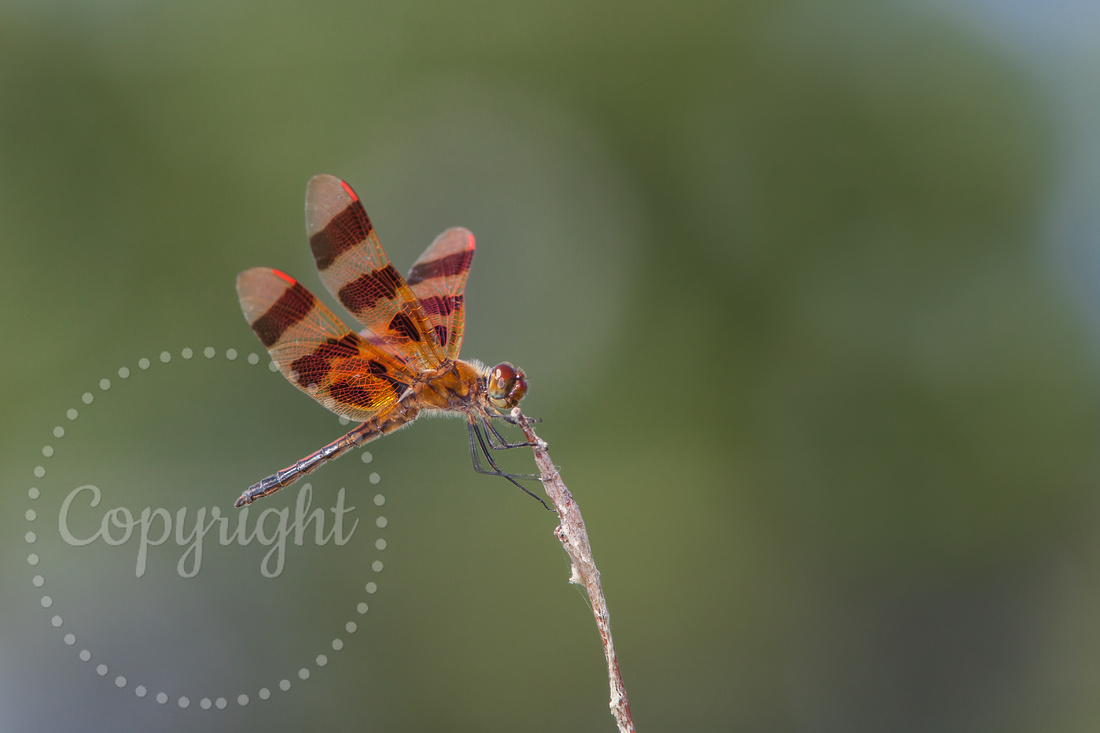
Halloween Pennant dragonflies just seem to light up when photographed using flash. They literally glow. Not sure why this is. Perhaps it is the reflections off the wings, how they are folded, or their color. The stigmas--located on the leading edge of the wing towards the wingtip--seem to burn especially bright, like landing lights on an airplane. I wonder how other dragonflies--which can see across a wider spectrum of light than we can--view each other? It must be a spectacular world....
Equipment Setup
- Canon 5D
- Canon 300mm + 1.4x teleconverter
- Canon 430EX II flash
- ISO: 320, f-stop: f10, Shutter: 1/320 sec.
Scenario
To get shot, I set up using the equipment above and concentrated on a twig that the Halloween Pennant seemed to prefer. (Other dragonflies were using it as well.) Usually I use a -1 f-stop compensation on the flash, but didn't in this instance as I really wanted to capture the glow of the wings. I specifically chose a distant background across the pond consisting mostly of trees and some sky. That selection added additional color to the photo and contrasted nicely with the dragonfly's wings.
Nature Notes
Dragonflies, such as this Halloween Pennant, often patrol territories and often hang out of favorite perches to rest and watch for both prey and other male pennants (which they chase away) or interested females (with which to breed).
Halloween Pennants often perch on the tips of twigs, as this one is doing, where they swing back and forth in the breeze, hence their name "pennant". The Halloween part of their name comes from their colors of orange and black (or brown).